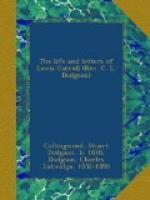How
can I tell what beauty is her dole,
Who
cannot see her countenance for her soul?
So entirely occupied is he with her gentleness, her pity, her sincerity, and her love.
Again, the reality of children appealed strongly to the simplicity and genuineness of his own nature. I believe that he understood children even better than he understood men and women; civilisation has made adult humanity very incomprehensible, for convention is as a veil which hides the divine spark that is in each of us, and so this strange thing has come to be, that the imperfect mirrors perfection more completely than the perfected, that we see more of God in the child than in the man.
And in those moments of depression of which he had his full share, when old age seemed to mock him with all its futility and feebleness, it was the thought that the children still loved him which nerved him again to continue his life-work, which renewed his youth, so that to his friends he never seemed an old man. Even the hand of death itself only made his face look more boyish—the word is not too strong. “How wonderfully young your brother looks!” were the first words the doctor said, as he returned from the room where Lewis Carroll’s body lay, to speak to the mourners below. And so he loved children because their friendship was the true source of his perennial youth and unflagging vigour. This idea is expressed in the following poem—an acrostic, which he wrote for a friend some twenty years ago:—
Around
my lonely hearth, to-night,
Ghostlike
the shadows wander:
Now
here, now there, a childish sprite,
Earthborn
and yet as angel bright,
Seems
near me as I ponder.
Gaily
she shouts: the laughing air
Echoes
her note of gladness—
Or
bends herself with earnest care
Round
fairy-fortress to prepare
Grim
battlement or turret-stair—
In
childhood’s merry madness!
New
raptures still hath youth in store:
Age
may but fondly cherish
Half-faded
memories of yore—
Up,
craven heart! repine no more!
Love
stretches hands from shore to shore:
Love
is, and shall not perish!
His first child-friend, so far as I know, was Miss Alice Liddell, the little companion whose innocent talk was one of the chief pleasures of his early life at Oxford, and to whom he told the tale that was to make him famous. In December, 1885, Miss M.E. Manners presented him with a little volume, of which she was the authoress, “Aunt Agatha Ann and Other Verses,” and which contained a poem (which I quoted in Chapter VI.), about “Alice.” Writing to acknowledge this gift, Lewis Carroll said:—




